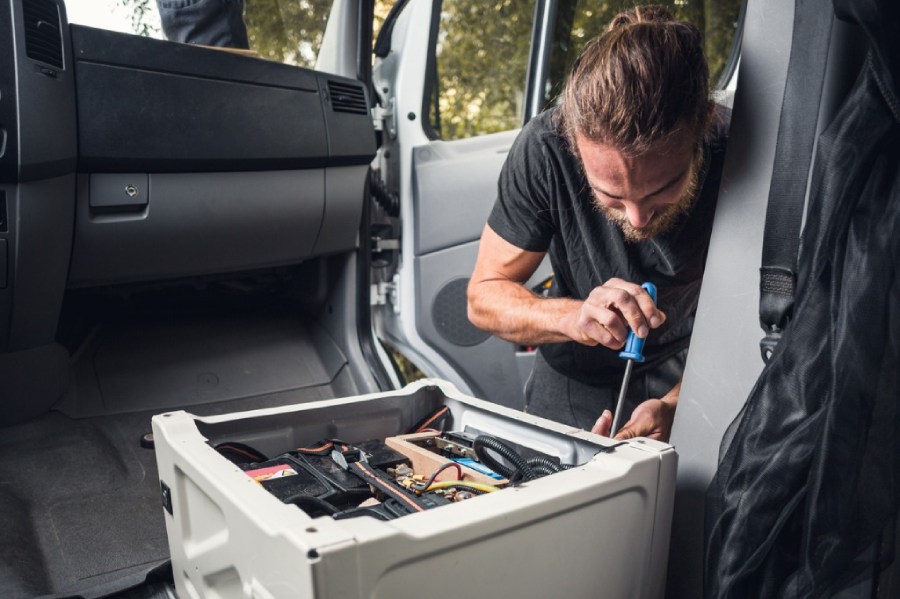The key to traveling as an overlander is to own gear that is well secured but can also tolerate a lot of bumping around. Unlike an RV, you’re not going to take your overlanding vehicle onto a paved site or down many well-kept roads; the whole point is to get far into the wilderness and get a break from civilization. The batteries you use to power your gear need to fit your travel goals.
You Need Sealed Batteries
While many RVs have some sort of sealed batteries, there are still plenty out there with the old-style lead acid batteries. The common name for these batteries is “golf cart” because they are used to power the electric golf carts driven from hole to hole. Lead acid batteries will leak if bounced around and need to be vented.
Sealed batteries either have an absorbent glass mat (AGM) to maintain the moisture necessary for charging and transferring power, or they have a separator to allow electricity to collect and discharge power. Both AGMs and lithium-ion batteries are sealed and can tolerate tipping and even storage on their side.
Consider Watt Per Ounce
While AGMs and lithium-ion batteries can be stored on their sides, an AGM battery will put a lot of weight on your overlanding vehicle. A 100-watt AGH battery can be over 60 pounds, while a lithium-ion 100-watt battery is only about 26 pounds.
Store your batteries in a low spot in your overlanding vehicle. Your battery output can be limited by heat; while it’s unlikely that the battery will be damaged by overheating, it will shut down and leave you without power. Allow for airflow around your battery, and don’t overload the space with heat-trapping products like sleeping bags or heavy outerwear.
Another way to protect your lithium-ion battery is to put down a shock-absorbing mat to protect it from chatter damage. A heavy-duty door mat can work. Asking your battery to shake, rattle and roll down your favorite off-road trails can shorten the life of even a sealed battery.
If you notice that your lithium-ion battery has started to swell or smell bad, you will need to find a safe recycling spot to avoid environmental risk. Never try to open a swollen battery. It can blow up.
Partial Charges Still Work
The ideal charge for most lithium ion batteries is about 85%. However, you won’t harm the battery by only giving it a partial charge. If you’re traveling with a solar panel, try to set it out at a high angle when the sun comes up to capture as much power as possible; as long as the panel collects rays, you’re charging.
No matter what you’re charging, most lithium-ion batteries offer an automatic shut-off; you can go ahead and run that refrigerator to keep everything cold while the sun is up. If the battery gets too low, the output will simply stop.
Another option is to charge your “house” or lithium-ion battery from your vehicle’s battery. In an RV or a van, this is fairly straightforward, and the wiring can be run through the vehicle’s frame. However, because your overlanding vehicle will be climbing over some tough terrain, you may do better to store the battery closer to the front of your vehicle to shorten that wire run.
Battery Life
Because overland lithium batteries have an automatic shutdown, they will survive longer. Lithium-ion batteries also provide many more cycles, or full discharge to full recharge, than lead acid or AGM batteries. Make sure you get the batteries with the automatic shut-off when considering the best way to power the gear in your overland vehicle or RV.
All batteries will generate heat when they are in use, either when they’re charging or producing power for your devices. However, some lithium-ion batteries that don’t have the shut-off option can start a thermal runaway fire that is toxic and very hard to put out.
Anyone who loves the great outdoors knows the extreme risk of forest fires, particularly in the American west. If you’re planning another trip into the wilderness, now is the time to charge your batteries inside the vehicle so you can monitor heat build-up. If you notice any odor or swelling, you need new batteries.
